#case solving
Explore tagged Tumblr posts
Text
proud to say that I have never once in my life figured out the whodunit in any crime story I've read or watched. I just let the facts and clues wash over me, absorbing absolutely none of it. I am the audience they think of when they throw in red herrings, in case you've ever wondered "who would fall for this obvious false lead". it's me. I am the idiot viewer/reader. not once has an obviously framed clue revealed anything to me. my head is completely empty when I consume these stories.
#rover rambles#I joke a lot about how stupid hastings is#but in truth I am about as good as solving these cases as he is#possibly even worse somehow#and it's not for lack of wanting to solve them#in fact I have attempted it many times#I simply am stupid
27K notes
·
View notes
Text
There’s a new drug in Gotham making the rounds, one synthesized by Two-Face’s people; if you take it you will have a 50/50 chance that you’ll experience the greatest high of your life or that you’ll die.
Batman is desperately trying to find the main lab and cut off the production from the source and hasn’t been able to find a lead in weeks.
That’s when Gordon gives him a file that was given to him by a “white haired ghost kid”. It’s a detailed report written similarly to a scientific journal with detailed sources that are mainly first hand accounts from deceased victims of the Two-Face drug.
At the very end of the paper there’s an address to a Gotham University dorm room with a sticky note next to it that says “if you need help with death or the undead. Yours truly; Danny Fenton.”
#guys look at the tags I’m too lazy to add it to the main post#my thoughts as to why Danny hated English is because he’s helped write so many scientific papers for his parents the writing style#is ingrained into his day to day writing. this time tho he was trying to be professional for The Batman#he doesn’t want to step on Batman’s territory but since he now lives in Gotham might as well give the main powerhouse a#‘high just letting you know I’m in your city now’ gift#he doesn’t even try to hide his identity because he knows that Batman will find it eventually.#might as well help and fulfill his obsession as a consultant to the Bats#Batman now asks Danny to help with communing with the dead to help solve cases#dpxdc#danny phantom#dp x dc#bones prompts#bones writes in the tags
2K notes
·
View notes
Text
i need 7+ seasons of dead boy detectives specifically to see the long-term payoff of charles putting a jar of bees in his bag
#one day years from now he’s gonna pull it out and use it to solve a case or save somebody’s life#i need to see that payoff#and i need it to be long term#i need it to be so far in the future that everyone will have forgotten about that random little detail from the pilot#until it finally comes full circle#this show makes me insane#i want more of it so bad#dead boy detectives#dead boy detective agency#dbda#charles rowland
4K notes
·
View notes
Text

they should work together idk guys
#‘what could’ve been’ pairings make me SO UPSET BUT ITS SO GOOD AND INSANE#need them to hold hands while solving cases together#if you’re gonna follow me you have to go through all my seven different art styles#literally every art I made for this pair are different like how did this happen at all#meronia#mellonear#mello#near#mihael keehl#nate river#death note#death note fanart#myart#hope y’all aren’t sick of me
1K notes
·
View notes
Text
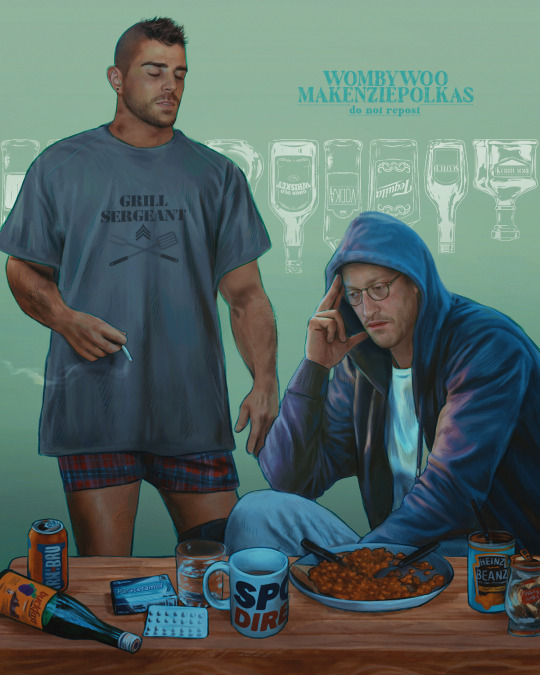
hungover 😓
#call of duty#cod#john soap mactavish#simon ghost riley#soapghost#ghostsoap#my art#simon stayed up all night watching youtube conspiracy videos and has solved the jack the ripper case#johnny is still asleep#it's 15:43 pm
4K notes
·
View notes
Text
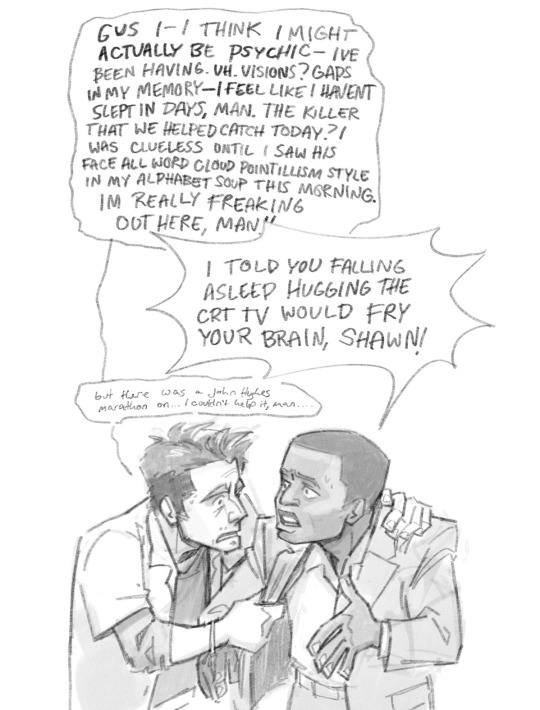
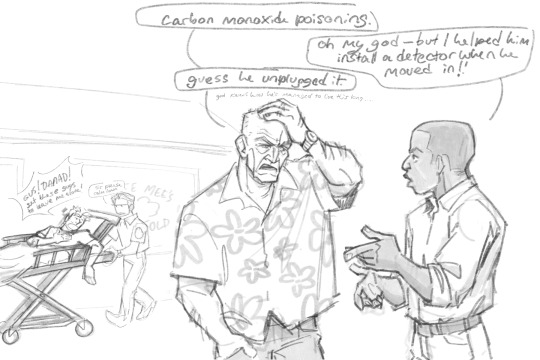
psych episode where shawn begins to have psychic premonitions (carbon monoxide poisoning)
#see he’s solving the cases. and then forgetting (CO) and then halllucinating a premonition based off of the memory he cant remember#i just think it would be funny#also never drawn henry before but. very fun man to draw#psych#psych fanart#psych tv#psych usa#psych show#psych shawn#shawn spencer#henry spencer#burton guster
7K notes
·
View notes
Text

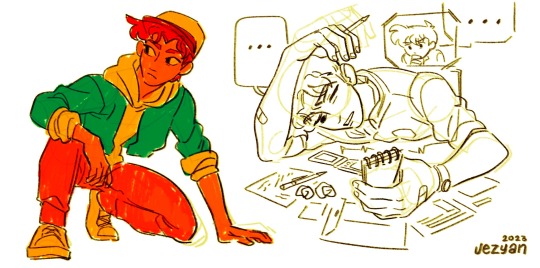


old doodles/warmups from last year ^^
#dcmk#detective conan#case closed#hattori heiji#kudo shinichi#tiny but there—#heishin#they’re solving a case together :]]#eyestrain#?#attempting to post regularly again… in the meantime#some backlogged doodles!#sketchbook
1K notes
·
View notes
Text

Day 3: A case/bag of tricks backpack
#charles rowland#charles rowland week#CRW#dbda fanart#dbda#dead boy detectives#illustration#digital art#fanart#my art#his string is cut cuz his case was never solved#:3
592 notes
·
View notes
Text
The idea of hell having a claim on Edwin's soul is such a fun avenue to explore. There's a lot of ways I like to think that could manifest.
Personally, I like the idea of the claim mark being inked around his throat like a tattoo, the whole way around it like a collar. It's why he wears his shirt buttoned up all the way and his bow tie all the time.
Something in another language or comprised of runes or other designs that indicate his soul is claimed, but it just looks wrong. There's no good way to describe it but even someone who didn't know it was a claim from hell would be unsettled by it.
And Charles hates it from the first time he sees it.
Especially the more he gets to know Edwin, the more it really sinks in how wrong the whole thing is.
And because the universe apparently just loves to fuck with Edwin, it also hurts. Ghosts can't bleed but sometimes it just kind of oozes a thick black liquid. It will burn, similar to the way iron burns, and it itches. Edwin will mindlessly scratch at it to the point where he'd be bleeding if he was living.
When he's in hell, it manifests as a actual iron collar. It's the same collar each time he comes back after being killed so it's rusted with old blood and forms jagged edges, ripping into the skin while it burns. When he scratches at it, he digs at the skin until it bleeds and sometimes further.
Edwin did not tell Charles about the physical collar. That might have been a misstep on his part, however in his defense he wasn't planning on ending up back in hell or Charles being in hell with him at any point.
So Charles, who's already burning with worry and rage, finds Edwin and learns what actually happens to him down here and finds out the whole time Edwin is collar like a dog... well. It doesn't go well.
Charles wants it off. The mark was bad enough but now he's got an actual fucking collar?
He wants it off Edwin. He wants it off right now. But there's no seam on the collar, it's like it was welded on. It's not meant to come off and it won't, not while they're still in hell.
It's burning into Edwin's skin when he tells Charles he's in love with him and honestly, Charles can barely focus on anything except getting Edwin out of there and that stupid fucking collar smoking and drawing blood.
But he knows he doesn't want to tell Edwin he loves him back right now. Not when they're still in hell with a monster chasing them, both of them exhausted and Edwin hurt.
He'll say it after they're safe and out of hell, after that collar is gone.
He's going to hit the ground running on figuring out how to break the whole damn claim. He hadn't pushed it as much as he should have. Edwin didn't like to talk about it or call attention to it and Charles respected that. He shouldn't have. He should have pushed it because even if Edwin only had the physical collar in hell, he still had the mark constantly.
Charles had spent many nights glaring at it, nights where it was just them in the office and Edwin actually let himself relax, undoing the buttons on his shirt until the mark was visible. His attention would always end up being drawn back to the mark, Edwin too focused on other things to notice.
If he said anything, or even got caught staring at it, he knew Edwin would snap shut. He wouldn't ever let it show again and he deserves a place to be able to relax and not worry about it. Plus, Charles knows that sometimes the mark is sensitive enough that the clothing rubbing against it makes it raw, being able to expose the mark and let it air out was a relief.
The claim gets pushed to the side with everything else that happens but when Charles gets Edwin off the table Esther had made, to torture him and Charles was rapidly coming to the conclusion that he was more than okay being incredibly violent if it means people will leave Edwin and him alone, the mark is dark and black liquid is rolling down his skin in big drips.
He's ready to get Crystal involved by the time they're finally back in the office, even though he knows Edwin has no desire for her to see or know about the curse, but things actually start to go their way.
They're given the okay to stay together and keep solving cases, and Edwin doesn't have to worry about going back to hell.
They're giving the night nurse some shit, welcoming her to the agency with tongue in cheek comments when she mentions something about the cursed claim and both of them straighten up.
It's nothing concrete, but it's worth a shot. Charles feels a little bad for flinging her off the cliff at the lighthouse because there must be something good in her for her to give them this. She could have said nothing and they never would have even thought to ask her.
She can't promise it will work and she doesn't even know if it's the right information but it gives them a place to start and that's more than enough.
Once your soul has been cursed and claimed in such a way, especially by something like hell, it can't ever be completely free again. Something with the makeup of the soul being altered. Ownership of the claim must be transferred to someone else, it isn't broken just shifted.
So, in the end, the only thing that can transfer a claim on a soul like Edwin's is a stronger claim.
Charles is like fucking finally. He's ready to rip Edwin's soul out of everyone else's hands at this point. No one's got a stronger claim on Edwin than him and he'll fight hell to prove it if he needs to.
And honestly, Edwin can't think of anyone else he'd want to have it.
The spell for the transfer works and the mark changes completely. The dark ink lightens to a off grey silver color that's hardly visible unless you look right at it. The edges of the letters/runes/shapes go from jagged and sharp to curved and soft.
The mark doesn't hurt, ooze black, burn, or itch anymore. In fact, Edwin would argue that it's warm, like it's trying to soothe more than anything else.
He would almost say it's pretty.
Charles gets a version of it on his wrist, wrapped around it like a bracelet. It shows more on him with his skin color and Edwin would say it's pretty.
Maybe it's sensitive and touching it on each other feels good. So Charles gets in the habit of brushing his hands over Edwin's throat and petting at the mark. Edwin gets in the habit of grabbing Charles's wrist and holding it, fingers soothing over the mark and the soft skin of Charles's inner wrist.
🌙🌙🌙🌙🌙
Idk just fun thoughts 🤷♀️
#dead boy detectives#payneland#edwin payne#charles rowland#dbda#fanfiction ideas#solving cases with greyskyflowers
769 notes
·
View notes
Text
“if death ever did catch us she’d force us into the afterlife and split us up”
honey death is the original ally
death let a scraggly homeless man live forever because her baby brother had a crush. death 1000% knows about the dead boy detective agency and she loves it. they’re her favourite little gay ghosts and they’re not going ANYWHERE
#i think about this a lot#there is no way she doesn’t know about them#she probably cheers them on every time they solve a case and she gets a new soul in the afterlife#she’s sitting back sipping a margarita like good one boys#another job well done#payneland#the sandman#dbd
432 notes
·
View notes
Text
rip jake peralta and shawn spencer you would have loved each other
#need them to solve a case together#this is a lame post i get that but its real to me#jake peralta#shawn spencer#b99#psych#psych tv#brooklyn 99
443 notes
·
View notes
Text

Another what-if pair up. They’d look so cute enjoying tea together. And have intellectual conversations probably.
#dragon age#dragon age the veilguard#DAtV#Emmrich volkarin#Neve Gallus#my art#go on detective cases together#neve having Emmrich converse with the dead victims Ahahah#easiest cases to solve from then on#talking about Tevinter and Nevarra magic and the difference in schooling#they’re both very different from the usual circles outside in Orlais and Ferelden and the free marches after all#talk things over teatime
745 notes
·
View notes
Text
A friendly encounter
While the others are dealing with their latest rogue, Damian investigates(in secret) the old Ace Waste Disposal Plant.


#melo's art#dpxdc#dcxdp#danny fenton#damian wayne#Batman and co. Are currently being trown around like ragdolls<3 on the other side of the city#While Damian finds a new case! (that he will totally solve by himself!!)#White coffin au#Danny is just vibing rn... Until he starts to puke his guts out and has to go back to his coffin. Uuuh as soon as he remembers where it is
540 notes
·
View notes
Text
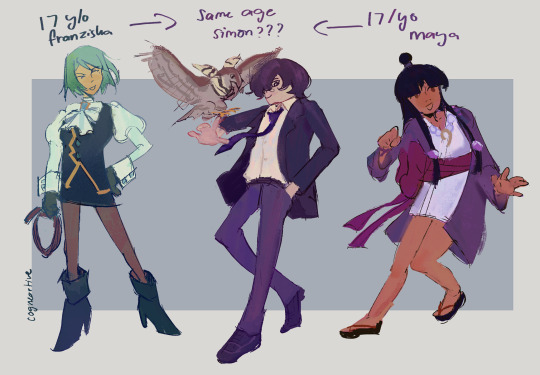
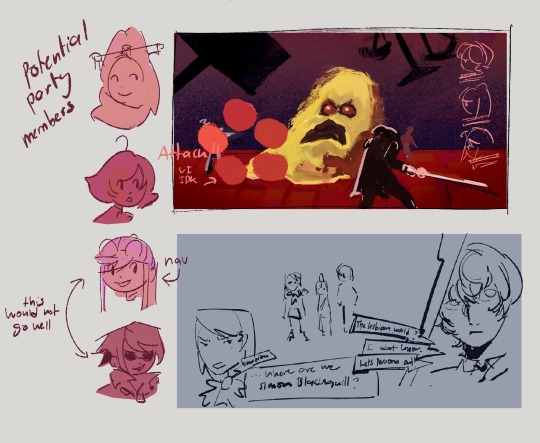



when i found out simon was around maya and franziska’s age i got frightened a little. then i put them all in persona + some old doodles i put in that seemed to fit
edit: i just realised i wrote the date wrong on aura’s tweet sigh. no that kid did his gcses at 12/13 years old dude
#ace attorney#franziska von karma#simon blackquill#maya fey#kay faraday#sebastian debeste#eustace winner#ema skye#klavier gavin#bobby fulbright#athena cykes#barok van zieks#<- cameo 😭 say hi#my art#i didnt put this in the post but ive actually thought of a persona au for them#premise idk simon goes to japanifornia to do a prosecutor internship and he meets some friends. yay!#solve a scary murder case go into the shadow court world and have some fun#you have to max rank athena and bobby for good ending okayyy#i just realised i wrote the day
298 notes
·
View notes
Text
CASE: SOLVED!
⌕ you want us to solve what?!
⌕ a k.bakugou, s.todoroki, i.imidoriya (seperately) x reader interactive smau series



⌕ she needed a new start, and japan's hero commision needed the world's best of the best private investigator. now that y/n l/n was asked to be stationed in japan, she'll be working side by side with the country's top three heroes to uncover a stalker's disguise. will they be able to find a solution for the case? and along the way, maybe a solution for her broken heart too.
⌕ pro hero!au, big three x reader, strangers (?) to co workers to lovers (?), swearing/language, fem!reader (reader is referred to with she/her pronouns), stalker activity, maybe ooc izuku I'm sorry</3
⌕ status: coming soon!
(☏) for chapters with written portions

⌕ frans' 1k special! readers will be able to decide the fate of characters involved in the series! who'll work with who, who'll make moves on the reader first, who'll go on dates with who? you get to decide!
CATCH THE SUSPECT! uquiz
TEASER, INTRODUCTIONS, CHAPTERS coming soon<3
© miyamoratsumuu 2024 please do not edit, translate, or repost onto any other platform

⌕ taglist: open!! (reply or send an ask to be added<3)

⌕ the series and whole concept of this is inspired by Panorama!!!, an Interactive Haikyuu SMAU series by the loveliest herself, @zumicho !! it's an amazing series. make sure to check it out along with ree's other works!!
AND TO ALL MY AMAZING MHA MOOTIES THAT MADE THIS POSSIBLE AAAAH TY ALL AND ILY ALL SM!!!! you guys won't believe the amount of times you inspired me to do more and do better, and I couldn't be more grateful 🙇🏻♀️
@whenanafallsinlove @angeliicheartt @poetlus @sepptember @satelitis @iloveroblox48 @sweetheartsaku @rueclfer @kovu-bunnbunn @izufeels @seumyo @loveriotss @lissdiary @xn4vyl1c1ousx @sunolls @lounaticcc @daetko
and ofc to my other moots too that I wasn't able to tag (it's either I'm shy or I'm shy 😞) I can't forget about you guys ofc!! all of your support means so much to me, words can't express how grateful I really am<3 LIKE REE AND NESS AND WYR AND YEN (imy yen) you guys were the no. 1 people I always looked up to, truly ILY!!
navigation ⌕ mha masterlist
#⚠️ case: solved!#animated dividers by @cafekitsune#🖇️[ my hero academia ]#🖇️[ smau series ]#mha#mha smau#mha smau series#mha x reader#boku no hero academia#bnha x reader#bnha smau#bnha smau series#katsuki bakugo#bakugou katsuki#bakugou x reader#bakugou smau#bakugou smau series#bakugo x reader#bakugo smau#bakugo smau series#shoto todoroki#todoroki x reader#todoroki smau#tosoroki smau series#izuku midoriya#izuku midoriya x reader#midoriya smau#midoriya smau series#deku x reader#deku smau
520 notes
·
View notes
Text
Danny is travelling around solving unsolved murders and it is infuriating the local heroes cus each of them have went through training from either batman or a batman approved trainer and nothing about the way he says he solved the cases add up but the killer confesses and how the fuck did he solve them
Notable ways he has solved cases include the blood "told" him he heard the knife drop he sensed the killers "vibe" he followed the footsteps of the spirits he asked the victim he smelled the killers scent and the killer stabed him and he "recognised his handie work"
Danny meanwhile is just doing a cross country trip and helping ghosts rest and families find peace by talking to ghosts and giving that info to the police
#dpxdc#dp x dc#dc x dp#dcxdp#dp x dc crossover#danny is pissing off every hero because he is giving them the info to solve the case#but he doesn't answer how he got it#and if he does it's either in a wierd way#a cryptic way#or a sarcastic way
1K notes
·
View notes